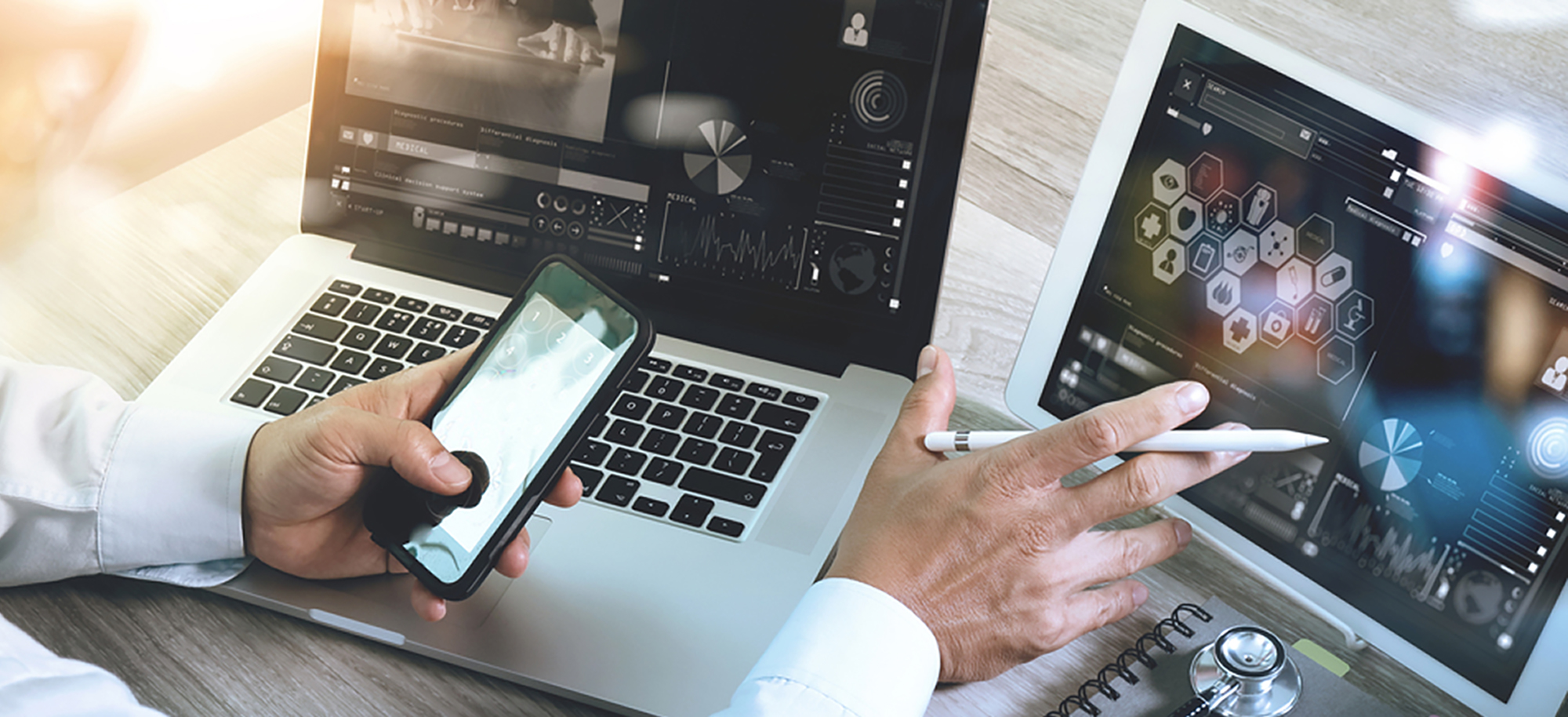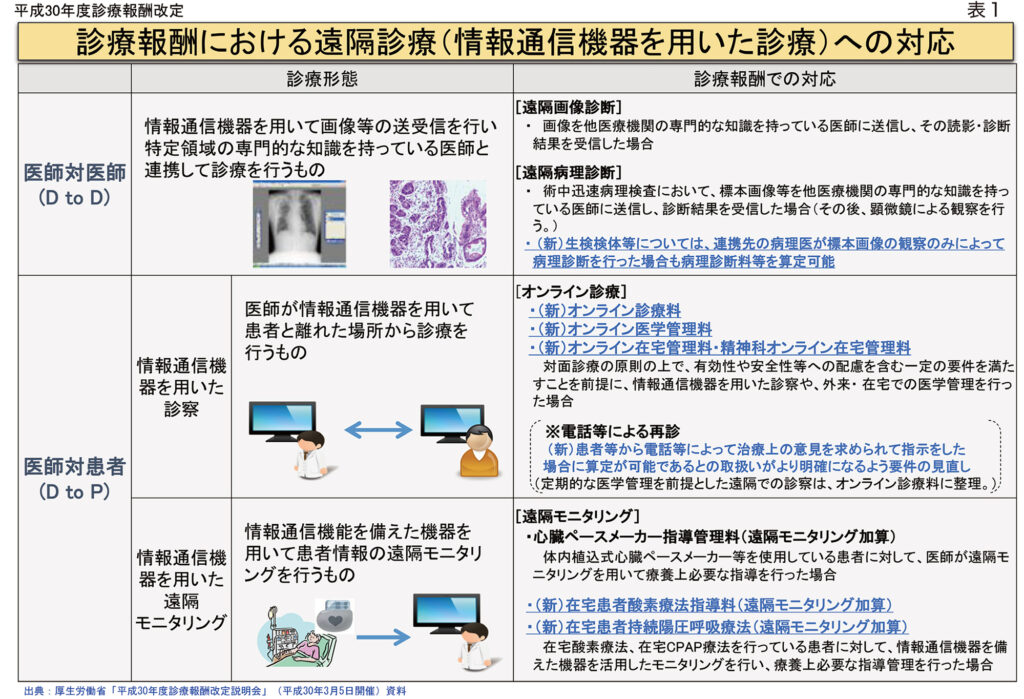Online medical treatment, whose position and definition in medical care has been ambiguous, will be evaluated in earnest in the 2018 medical fee revision. Behind this is the advancement of information and communication technology (ICT), including the spread of smartphones. Since 2018, online medical treatment has been clearly positioned in the medical fee system and guidelines have been established, so the required requirements have become stricter than before. Explore future developments in online medical care based on new developments.

The basic viewpoints in the 2018 medical fee revision are (1) construction of a comprehensive community care system and differentiation / strengthening of medical functions, promotion of cooperation, and (2) high-quality medical care that can respond to new needs and is safe, secure and convincing. Realization / enhancement, (3) reduction of burden on medical staff, promotion of work style reform, (4) strengthening of system stability / sustainability through efficiency / optimization.
This time, it is the same as the revision of the long-term care fee once every six years, so from the viewpoint of building a comprehensive community care system, the emphasis was placed on consistency and cooperation with the long-term care insurance system.
Telemedicine or online medical treatment evaluated in the 2018 medical fee revision is positioned in (2) of the above four basic viewpoints. "Evaluation of telemedicine" was mentioned in "Appropriate evaluation and steady introduction of advanced medical technology", which is one of the pillars.
The viewpoint of (3) is also noteworthy. Currently, the government and the Ministry of Health, Labor and Welfare (hereinafter referred to as "Ministry of Health, Labor and Welfare") are promoting "work style reform", and as part of this, they are trying to reduce the burden on doctors by utilizing ICT. Especially in areas where there is a shortage of doctors, medical care using ICT is considered to be useful and effective.
In the medical fee system from 2018, telemedicine is roughly divided into "doctor vs. doctor" and "doctor vs. patient". (table 1)

"Doctor vs. doctor" (commonly known as "D to D") is, for example, remote image diagnosis, telepathological diagnosis, and the like. For this "D to D", medical fees have been calculated for some time. However, when making a pathological diagnosis remotely, a pathological specimen had to be sent. This time, it was OK to send the sample image (digital pathological image) collected from the patient to a full-time doctor at another medical institution and receive the result.
"Doctor vs. patient" (commonly known as "D to P") is further divided into "medical examination using communication equipment" (online medical examination) and "remote monitoring using information communication equipment". The medical fee revision in 2018 made a new evaluation mainly for the "D to P" medical treatment form. In particular, new remuneration systems have been introduced for online medical care, such as online medical care fees, online medical management fees, and online home management fees.
In the future, the focus of "doctor-to-patient" telemedicine will be online medical fees (70 points, per January) and online medical management fees (100 points, per January).
The existing medical fee system is broadly divided into basic medical fees (initial / re-examination fees, hospitalization fees, etc.) and special medical fees (medical management, home medical care, examinations, diagnostic imaging, etc.). If that is the case, online medical fees are a type of re-examination fee (or outpatient medical fee). Therefore, the previous requirements for "re-examination by telephone, etc." were reviewed and organized. In addition, the online medical management fee corresponds to a new addition in "medical management, etc." in the special medical treatment fee.
Therefore, in principle, the first medical examination should be face-to-face medical treatment, and face-to-face medical treatment should be performed regularly thereafter, but the online medical treatment fee and the online medical management fee can be calculated together.
Online medical fees can be calculated for specific disease medical treatment management fees, regional comprehensive medical treatment fees, pediatric medical treatment guidance fees, dementia regional comprehensive medical treatment fees, epilepsy guidance fees, lifestyle-related disease management fees, intractable disease outpatient guidance management fees, and home medicine. Patients who have calculated the comprehensive management fee, diabetes dialysis prevention guidance management fee, and psychiatric home patient support management fee, and have passed 6 months or more from the month when those management fees were first calculated. In this way, it has become possible to deal with a wide range of activities such as pediatric and home medical care, centering on lifestyle-related diseases (Table 2).
The online medical management fee is applicable to specific disease medical treatment management fee, pediatric medical treatment guidance fee, epilepsy guidance fee, intractable disease outpatient guidance management fee, diabetes dialysis preventive guidance management fee, regional comprehensive medical treatment fee, dementia regional comprehensive medical treatment fee. , The patient who has calculated the lifestyle-related disease management fee and has passed more than 6 months since the first medical examination. Based on the medical treatment plan, medical management is performed by combining face-to-face medical care and online medical care, and it can be calculated according to the prescribed management fee only when the period from the month following the previous consultation month to the month before the current consultation month is February. However, the online medical management fee cannot be calculated in the month when the specific disease medical treatment management fee is calculated in face-to-face medical care.
The Ministry of Health, Labor and Welfare has set up the "Guideline Creation Study Group on Medical Care Using Information and Communication Equipment" and is continuing to study what kind of communication equipment should be used for online medical care. .. At the second study meeting held on March 9, 2018, the ministry submitted "Guidelines for Proper Implementation of Online Medical Care (Draft)", and after obtaining a general agreement, public comments were made to the public. Began to seek opinions. At the 3rd meeting held on the 29th of the same month, the "Guidelines for the Appropriate Implementation of Online Medical Care" was finally finalized.
Specific examples to which this guideline is applied include (1) confirmation of blood pressure control in hypertensive patients, (2) diagnosis of patients on remote islands as suspected fractures, explanation of procedures such as cast fixation, and (3) interviews with patients. , Implementation of consultation recommendation to appropriate clinical department (online consultation recommendation), etc. are mentioned. In addition, it shows "minimum compliance items", "recommended items", "desirable examples", "inappropriate examples", etc., and is likely to be a practical guideline.
Regarding the terminal on the patient side in online medical care, the "Guidelines for Proper Implementation of Online Medical Care" states that it is assumed that the terminal will be used by a smartphone, etc. contracted by the individual patient, and in order to prevent unauthorized access due to it, for example, ID. / Appropriate identity verification (authentication) on the patient's terminal, such as setting a password, is to be carried out. Also, on the patient side, it is possible to communicate using the camera and microphone built into the laptop computer, or to combine the computer and smartphone, but in this case as well, the same caution is required.
In addition, under the revised Personal Information Protection Law that came into effect on May 30, 2017, the results of medical history and health examinations are regarded as "personal information requiring consideration" so that unfair discrimination, prejudice and other disadvantages do not occur. It was decided that special consideration should be given to handling. It is assumed that the patient wants online medical treatment during the lunch break of the company, but it can be said that it is extremely problematic to carry out online medical treatment in the presence of colleagues in the company.
Considering these points, it is desirable for patients to receive online medical care in a calm environment at home / at home. In reality, patients with various illnesses are targeted for online medical care, and there are also appropriate times for each patient. On the medical institution side, the point of response seems to be how far online medical treatment can be reserved at a specific time.
In the actual medical treatment, the medical treatment time is reserved in advance. When the time comes, start up your smartphone or computer and connect to a doctor such as a clinic. While looking at the patient's face, the doctor cuts out a story such as "Isn't there any change?" And starts the examination. The big advantage for patients is that there is no hospital visit time or waiting time. Elderly people often have weak legs or need to be accompanied, and the burden is lightened. You will receive your prescription by mail. Payments are often made by credit card, etc. Online medical care is also likely to be effective in home-visit medical care. If patients and their families can see the doctor's face and consult with them, they will feel more secure and the burden of visiting the doctor will be reduced.
On the other hand, as for telemedicine between medical institutions, Showa University has begun to introduce the Remote Intensive Care Patient Management Program (eICU), which is one of the telemedicine mechanisms for critically ill departments. With eICU, 50 beds in the intensive care unit (ICU) of the hospital and Showa University Koto Toyosu Hospital will be managed remotely 24 hours a day. With eICU, not only can the changes in the condition of each patient be grasped on the monitor, but also the positional relationship of the critically ill patients in the hospital can be immediately known, so betting in the critically ill department can be efficiently managed. There is also the advantage that treatment policies can be discussed between on-site staff and doctors in remote areas. While the number of elderly patients entering the ICU is increasing, there is a shortage of intensive care specialists, so management with advanced systems can ensure the quality of medical care. In the United States, the introduction of eICU will improve the mortality rate of critically ill patients and shorten the length of hospital stay. In addition, Asahikawa Medical University provides telemedicine at two clinics, China-Japan Friendship Clinic (Beijing City) and Rui Jin Clinic (Shanghai City) in China, and supports radiology image interpretation, ophthalmic treatment, pathological diagnosis, etc. I am doing.
There were various circumstances before telemedicine was evaluated. In the 1997 telemedicine notification, "patients in remote islands and remote areas" were exemplified as "when it is difficult to perform direct face-to-face medical care" for the target of telemedicine. In the 2015 telemedicine office communication, he emphasized that it is just an example. In addition, in the 2017 telemedicine notification, useful information that can be substituted for direct face-to-face medical treatment is obtained even for telemedicine that combines information and communication devices such as videophone, e-mail, and social networking service (SNS). In that case, he explained that it does not immediately violate Article 20 of the Medical Practitioners Act (prohibition of non-examination treatment, etc.).
The office communication and notifications have clarified to some extent the areas where telemedicine is not illegal, and medical institutions that are actively engaged in telemedicine have begun to appear, especially in large cities. The convenience and usefulness of telemedicine has come to be recognized for patients with lifestyle-related diseases who are busy with work and have difficulty in going to the hospital. However, the position and evaluation of medical fees were not clear. The Ministry of Health, Labor and Welfare could not leave such a situation unattended, and this time, telemedicine was incorporated into the medical fee system, and after applying certain restrictions, it was decided to spread it.